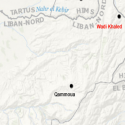 |
 |
Fallout in Lebanon: The Impact of Yabroud
May 16, 2014 - Geoffrey Daniels


The Syrian regime’s decisive victory over rebel forces in the Qalamoun stronghold of Yabroud, bolstered by support from Lebanese Hezbollah and Syrian National Defense Forces, has significant implications in the overall context of the three-year conflict. Yet also worth a careful examination is the impact of the fall of Yabroud on Syria’s fragile neighbor, Lebanon, whose own security situation remains fragile as the conflict continues to spill across the border. The ripple effects from Yabroud test the resilience of Lebanon, a country less than one decade removed from a 29-year Syrian military occupation, by flooding the border regions of Arsal and Wadi Khaled with militants, weapons, explosives, and refugees while threatening tenuous sectarian divisions.
IMPACT IN LEBANON
Violence related to the Syrian civil war has permeated nearly every major region in Lebanon, including Beirut, Tripoli, Sidon, and the Bekaa Valley, where supporters and opponents of the Assad regime have exchanged increasingly frequent reprisal attacks since April 2013. Particularly, as a consequence of its role in Syria, Hezbollah has been the target of multiple vehicle-borne improvised explosive devices (VBIEDs) from domestic and external opposition, the majority of which were facilitated with support from the border regions. In 2014 alone, Hezbollah strongholds in Lebanon have been hit by VBIEDs on eight separate occasions, resulting in more than 30 casualties with hundreds more wounded.
Prior to the takeover of the rebel stronghold of Yabroud by pro-regime forces on March 15, the western Syrian town functioned as the primary staging area and support zone for Sunni extremist groups targeting Hezbollah fixtures in Lebanon, thus delineating the capture of the town as a central objective in Hezbollah’s Syrian campaign. The offensive in Qalamoun, which began back in November 2013, was a phase of a broader initiative by Hezbollah and pro-regime forces to secure the Lebanese border with the stated intent of “ending the development of [terrorist] cells and armed groups…in the Qalamoun area until it is completely secured and is geographically linked with [Syria’s] Qalaat al-Hosn.”
Pro-regime forces conducted simultaneous offensives in the Qalamoun region of Yabroud and Qalaat al-Hosn in early March, producing ripple effects in two distinct geographic areas of Lebanon: the eastern Bekaa Valley town of Arsal and the northern Akkar village of Wadi Khaled, both of which already hosted vast networks of Syrian rebels and refugees. Field hospitals in Arsal and Wadi Khaled received the wounded, solidifying the status of the towns as an extension of the fighting in Syria to its regime opponents. Following up, the Syrian Air Force conducted daily airstrikes on the outskirts of the towns, targeting fleeing rebel fighters in a concerted effort to prevent their reconstitution in Lebanon.
In the wake of victory in Yabroud, however, Hezbollah incurred immediate retaliatory attacks in its Bekaa Valley strongholds. A suicide car bomb targeted the Shi’a village of Nabi Othman, near the Hezbollah stronghold of Labweh, killing four Hezbollah officials and wounding several others. Jabhat al-Nusra’s Lebanese branch claimed responsibility for the attack as retribution for the capture of Yabroud, calling it a “swift response to the swaggering and ranting of Iran’s party [Hezbollah].”